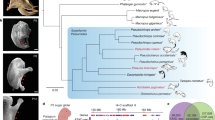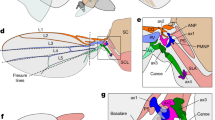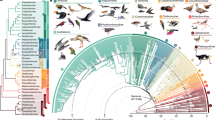Abstract
The evolution of avian flight remains one of biology’s major controversies, with a long history of functional interpretations of fossil forms given as evidence for either an arboreal or cursorial origin of flight. Despite repeated emphasis on the ‘wing-stroke’ as a necessary avenue of investigation for addressing the evolution of flight1,2,3,4, no empirical data exist on wing-stroke dynamics in an experimental evolutionary context. Here we present the first comparison of wing-stroke kinematics of the primary locomotor modes (descending flight and incline flap-running) that lead to level-flapping flight in juvenile ground birds throughout development (Fig. 1). We offer results that are contrary both to popular perception and inferences from other studies5,6,7. Starting shortly after hatching and continuing through adulthood, ground birds use a wing-stroke confined to a narrow range of less than 20°, when referenced to gravity, that directs aerodynamic forces about 40° above horizontal, permitting a 180° range in the direction of travel. Based on our results, we put forth an ontogenetic-transitional wing hypothesis that posits that the incremental adaptive stages leading to the evolution of avian flight correspond behaviourally and morphologically to transitional stages observed in ontogenetic forms.

Our data suggest a default or basal wing-stroke is used by young and adults and may exist in all birds (Supplementary Videos). The fundamental wing-stroke described herein is used days after hatching and during all ages and over multiple behaviours (that is, flap-running, descending and level flight) and is the foundation of our new ontogenetic-transitional wing hypothesis. At hatching, chicks can ascend inclines as steep as 60° by crawling on all four limbs. From day 8 through adulthood, birds use a consistently orientated stroke-plane angle over all substrate inclines during wing-assisted incline running (red arcs) as well as during descending and level flight (blue arcs). Estimated force orientations from this conserved wing-stroke are limited to a narrow wedge (see Fig. 3b).
This is a preview of subscription content, access via your institution
Access options
Subscribe to this journal
Receive 51 print issues and online access
$199.00 per year
only $3.90 per issue
Buy this article
- Purchase on Springer Link
- Instant access to full article PDF
Prices may be subject to local taxes which are calculated during checkout


Similar content being viewed by others
References
Gauthier, J. A. & Padian, K. in The Beginnings of Birds: Proc. Int. Archaeopteryx Conf., Eichstatt 1984 (eds Hecht, M. K., Ostrom, J. H., Viohl, G. & Wellnhofer, P.) 185–197 (Freunde des Jura-Museums, Eichstatt, West Germany, 1985)
Padian, K. The origins and aerodynamics of flight in extinct vertebrates. Paleontology 28, 413–433 (1985)
Padian, K. & Chiappe, L. M. The origin of birds and their flight. Sci. Am. 278, 38–47 (1998)
Padian, K. in New Perspectives on the Origin and Early Evolution of Birds. Proc. Int. Symp. in Honor of J. H. Ostrom (eds Gauthier, J. A. & Gall, L. F.) 255–272 (Special Publication of the Peabody Museum of Natural History, New Haven, 2001)
Tobalske, B. W. & Dial, K. P. Flight kinematics of black-billed magpies and pigeons over a wide range of speeds. J. Exp. Biol. 199, 263–280 (1996)
Hedrick, T. L., Tobalske, B. W. & Biewener, A. A. Estimates of circulation and gait change based on a three-dimensional kinetic analysis of flights in cockatiels (Nymphicus hollandicus) and ringed turtle-doves (Streptopelia risoria). J. Exp. Biol. 205, 1389–1409 (2002)
Park, K. J., Rosén, M. & Hedenström, A. Flight kinematics of the barn swallow (Hirundo rustica) over a wide range of speeds in a wind tunnel. J. Exp.Biol. 204, 2741–2750 (2001)
Dial, K. P. Wing-assisted incline running and the evolution of flight. Science 299, 402–404 (2003)
Bundle, M. W. & Dial, K. P. Mechanics of wing-assisted incline running (WAIR). J. Exp. Biol. 206, 4553–4564 (2003)
Dial, K. P., Randall, R. J. & Dial, T. R. What use is half a wing in the ecology and evolution of birds? Bioscience 56, 437–445 (2006)
Tobalske, B. W. & Dial, K. P. Aerodynamics of wing-assisted incline running in birds. J. Exp. Biol. 210, 1742–1751 (2007)
Chiappe, L. M. Glorified Dinosaurs: The Origin and Early Evolution of Birds (Wiley, New York, 2007)
Witmer, L. M. in Mesozoic Birds: Above the Heads of Dinosaurs (eds Witmer, L. M. & Chiappe, L. M.) 3–30 (Univ. California Press, Berkeley, 2002)
Gatesy, S. M. & Baier, D. B. The origin of the avian flight stroke: a kinematic and kinetic perspective. Paleobiology 31, 382–399 (2005)
Sibley, C. G. & Ahlquist, J. E. Phylogeny and Classification of Birds, a Study in Molecular Evolution (Yale Univ. Press, New Haven, 1990)
Warrick, D. R. & Dial, K. P. Kinematic, aerodynamic and anatomical mechanisms in the slow, maneuvering flight of pigeons. J. Exp. Biol. 201, 655–672 (1998)
Hedrick, T. L. & Biewener, A. A. Low speed maneuvering flight of the rose-breasted cockatoo (Eolophus roseicapillus) I. Kinematic and neuromuscular control of turning. J. Exp. Biol. 210, 1897–1911 (2007)
Feduccia, A. & Tordoff, H. B. Feather of Archaeopteryx: asymmetric vanes indicate aerodynamic function. Science 203, 1021–1022 (1979)
Norberg, U. M. in The Beginnings of Birds: Proc. Int. Archaeopteryx Conf., Eichstatt 1984 (eds Hecht, M. K., Ostrom, J. H., Viohl, G. & Wellnhofer, P.) 293–302 (Freunde des Jura-Museums, Eichstatt, West Germany, 1985)
Norberg, R. A. in The Beginnings of Birds: Proc. Int. Archaeopteryx Conf., Eichstatt 1984 (eds Hecht, M. K., Ostrom, J. H., Viohl, G. & Wellnhofer, P.) 303–318 (Freunde des Jura-Museums, Eichstatt, West Germany, 1985)
Speakman, J. R. & Thomson, S. C. Feather asymmetry in Archaeopteryx. Nature 374, 221–222 (1995)
Garner, J. P., Taylor, G. K. & Thomas, A. L. R. On the origins of birds: the sequence of character acquisition in the evolution of avian flight. Proc. R. Soc. Lond. B 266, 1259–1266 (1999)
Paul, G. S. Dinosaurs of the Air (Johns Hopkins Univ. Press, Baltimore, 2002)
Segre, P. & Dial, K. P. Half a wing in motion: the ontogeny and wing kinematics of WAIR in chukars. Int. Comp. Biol. 45, 1191 P2.48. (2006)
Ostrom, J. H. Some hypothetical anatomical stages in the evolution of avian flight. Smithson. Contr. Paleobiol. 27, 1–21 (1976)
Jenkins, F. A. The evolution of the avian shoulder joint. Am. J. Sci. 293, 253–267 (1993)
Xu, X. et al. Basal tyrannosauroids from China and evidence for protofeathers in tyrannosauroids. Nature 431, 680–684 (2004)
Padian, K. & Dial, K. P. Origin of flight: could ‘four-winged’ dinosaurs fly? Nature 438, E3 (2005)
Jones, T. D., Farlow, J. O., Ruben, A., Henderson, D. H. & Hillenius, W. J. Cursoriality in bipedal archosaurs. Nature 406, 716–718 (2000)
Acknowledgements
We thank the following for their suggestions and comments: A. Biewener, M. Bundle, R. Callaway, H. Davis, S. Gatesy, D. Irschick, F. Jenkins, Jr, J. Maron, T. Martin, K. Padian and B. Tobalske.
Author Contributions K.P.D. provided the conceptual foundation, funding and facilities. K.P.D. and B.E.J. wrote the manuscript. B.E.J. and P.S. performed most data acquisition and analyses.
Author information
Authors and Affiliations
Corresponding author
Supplementary information
Supplementary Information 1
The file contains Supplementary Figures S1-S2, Supplementary Methods and Legends to Supplementary Videos 1-4. (PDF 935 kb)
Supplementary Information 2
This file contains Supplementary Video 1. (MOV 2755 kb)
Supplementary Information 3
This file contains part one of the Supplementary Video 2. (MOV 10077 kb)
Supplementary Information 4
This file contains part two of the Supplementary Video 2. (MOV 6616 kb)
Supplementary Information 5
This file contains part one of the Supplementary Video 3. (MOV 9237 kb)
Supplementary Information 6
This file contains part two of the Supplementary Video 3. (MOV 2469 kb)
Supplementary Information 7
This file contains part one of the Supplementary Video 4. (MOV 13143 kb)
Supplementary Information 8
This file contains part two of the Supplementary Video 4. (MOV 8722 kb)
Rights and permissions
About this article
Cite this article
Dial, K., Jackson, B. & Segre, P. A fundamental avian wing-stroke provides a new perspective on the evolution of flight. Nature 451, 985–989 (2008). https://doi.org/10.1038/nature06517
Received:
Accepted:
Published:
Issue Date:
DOI: https://doi.org/10.1038/nature06517
This article is cited by
-
Escape behaviors in prey and the evolution of pennaceous plumage in dinosaurs
Scientific Reports (2024)
-
Birds repurpose the role of drag and lift to take off and land
Nature Communications (2019)
-
Evolution: Doing the locomotion
Nature (2016)
-
A combined MR and CT study for precise quantitative analysis of the avian brain
Scientific Reports (2015)
-
Dietary mercury exposure causes decreased escape takeoff flight performance and increased molt rate in European starlings (Sturnus vulgaris)
Ecotoxicology (2014)
Comments
By submitting a comment you agree to abide by our Terms and Community Guidelines. If you find something abusive or that does not comply with our terms or guidelines please flag it as inappropriate.



